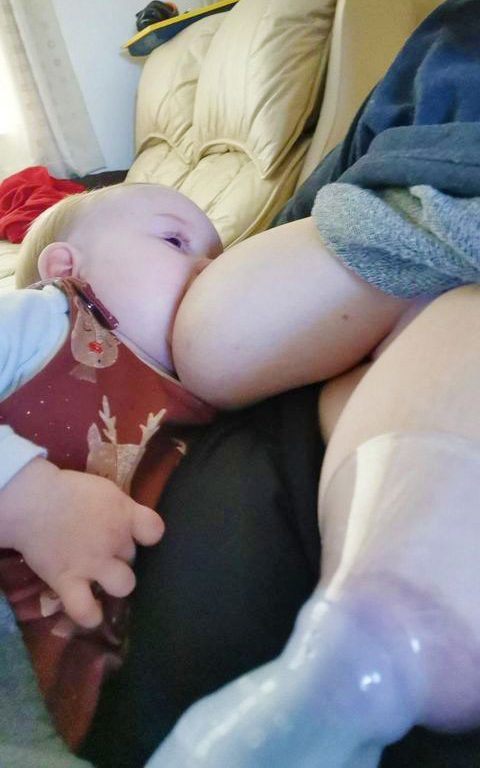Do you have a silicon suction pump? I’m talking about those little suction devices that look a bit like a flower vase and have become a standard piece of breastfeeding kit over the last few years.
They weren’t around when I had my first baby nearly 10 years ago, but by the time I had my second baby 4 years ago, they were commonplace.
Some parents find them really useful! The principle behind them is that you attach one to the breast that isn’t in use when you are feeding your baby, and they collect the letdown. Or, if you have a single breast pump, you can use a silicone suction pump on the opposite breast. It’s a quick and easy way of collecting a little bit of extra milk. Time is at a premium when you’ve just had a baby, so it can be an efficient use of time. I’ve also seen them being used for blocked ducts and milk blebs. If you love your little silicone suction pump and have had no issues, then GREAT! I understand that there can be some real benefits to using them.
However, you could be mistaken for thinking that these little suction pumps are essential. They’re really not. Women have been breastfeeding for millennia before they were invented. And, to be honest, as an IBCLC, I’ve seen some issues arising due to their use.
You could be mistaken for thinking that these little suction pumps are essential.
What are my 3 big concerns with the silicone suction pump?
Let’s look at what my three big concerns are for using a silicon suction pump…
1. They can get in the way of good positioning at the breast
To be honest, this can be an issue with any pump, not just the silicone suction ones! When baby is positioned well at the breast, their chin is buried in the breast, and their head is tipped back slightly. This allows for the tongue to hold the breast tissue securely in their mouth. Basically, the closer the chin and tongue are to the breast, the better the tongue can work.
Remember: it’s the tongue holding the breast securely that allows that transfer of milk. Baby can draw lots of breast tissue into their mouth, creating a good vacuum, and the tongue can then effectively move the milk back through their mouth and swallow it. In order to get the chin onto the breast, your baby’s body needs to be tucked in close to you, ideally with their chin, chest, hips and legs all in close contact with you. The closer baby’s body is, the deeper the latch.
If you have a silicone breast pump on one breast, it might just be sitting in the way of where baby’s body needs to be. I’ve seen some mums move their babies’ bodies away to accommodate the silicone pump. This often brings the baby’s nose and forehead closer to the breast, and the chin away from the breast. Just remember: your baby’s position is essential for a good latch. Prioritize the baby’s position over the pump’s position.

If you have a silicone breast pump on one breast, it might just be sitting in the way of where baby’s body needs to be.
Need to collect a bit of extra milk? Most mums find that their milk supply is highest in the morning, and their babies are usually reasonably settled, and may sleep a little longer between feeds. Pumping or hand expressing for 5 -10 minutes after a morning feed usually yields some milk fairly easily.
2. Often in the early days, babies benefit from frequent feeding from both breasts
There is a good chance that if baby feeds from one breast and there is a silicone pump on the other breast, baby will transfer less from the second breast, because the pump has removed some of the milk already. I do see mums who are struggling with their baby’s weight gain, desperate to catch every last drop of milk to feed to their baby. Let’s not complicate things: feed your baby, not your fridge. Get as much milk as possible into your baby directly from the breast. If you are struggling with supply, or slow weight gain, there are better options than one of these, I think.
Let’s not complicate things: feed your baby, not your fridge. Get as much milk as possible into your baby directly from the breast.
My absolute favourite way of boosting milk supply (and weight gain) is switch feeding. It takes a bit of concentration, but it is very effective. When your baby starts to feed, you’ll hopefully notice some big sucks and swallows with the first letdown. Then, you’ll notice your baby moves into faster sucks without many swallows. When your baby is doing the fast sucks, SWITCH them to the other breast, and watch for the big sucks and swallows. When they move into the faster sucks with no swallows, SWITCH them back to the first breast, and so on.
You may need to feed 2-3 times from each breast, so a total of 4-6 switches! This helps your baby transfer more milk, more quickly, and also stimulates your body to increase milk production. Sometimes, that is all you need to do to get feeding back on track. Other mums need to add in a few minutes of pumping after each breastfeed in order to further stimulate their milk supply.
If you’re worried about either your milk supply, or your baby’s weight gain, it’s a good idea to book a consultation with an IBCLC who can do a full assessment and come up with a plan to get things back on track.

3. These are not a passive milk collection device
For some women struggling with engorgement or oversupply, these silicone pumps can actually increase supply too much! Just because a silicone pump collects 3 oz doesn’t mean that a breast pad is collecting the same amount. A silicone pump, because it uses suction, will almost certainly collect more. I’d actually LOVE someone to do a study comparing these types of pumps, with milk collection shells/breast pads, and compare the volume of milk that gets collected!
I know so many women who have ended up with oversupply, blocked ducts, and mastitis, because their supply was stimulated too much. It’s ok to leak and “waste” a little bit of milk, especially if using a silicone pump is just going to cause too many problems for you. And if you can’t bear the thought of wasting even a drop of milk, you could try one of the milk collection shells that I mentioned.
I know so many women who have ended up with oversupply, blocked ducts and mastitis, because their supply was stimulated too much.
Do you need a silicone suction pump?
So what’s the bottom line? I’m not saying you shouldn’t use a silicone suction pump! Some women use them and find them incredibly helpful. Just know that, like any piece of breastfeeding equipment, they can cause issues. There are usually workarounds that mean you don’t need to purchase one. They certainly aren’t essential to successful breastfeeding, and personally, I’d rather spend the money on some nice snacks to eat while breastfeeding.

















